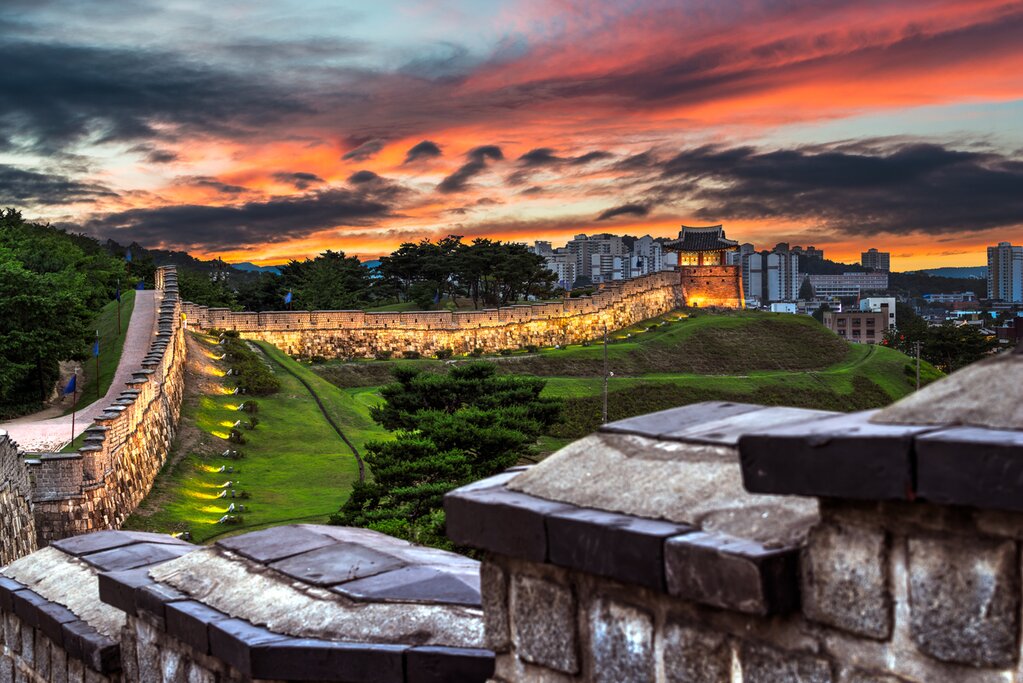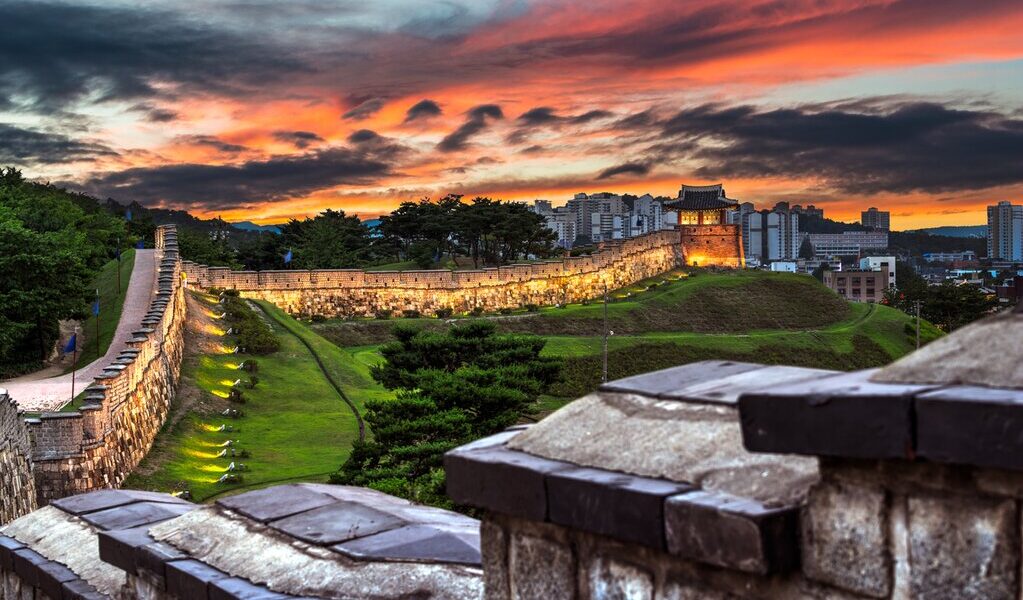
The fall season kicks off in South Korea in September. Cooler temperatures and an end to summer crowds make September ideal for sightseeing and outdoor activities. Tour top attractions in Seoul, Busan, and Jeonju, explore the country’s national parks and hiking destinations, or combine both for insight into South Korea’s culture, history, and natural beauty.
South Korea in September: A Comprehensive Travel Guide
## Weather in South Korea during September
The arrival of September signals the beginning of fall in South Korea, bringing welcome relief from the intense heat and humidity of summer. Temperatures begin to cool considerably, offering a more pleasant climate for exploring the country’s vibrant cities and engaging in outdoor adventures. The rainy season gradually comes to an end, though occasional showers are still possible, particularly at the beginning of the month. The average temperature hovers around a comfortable 66°F (19°C), a stark contrast to the oppressive heat experienced in August.
The balmy weather creates the perfect conditions for discovering the many facets of South Korea, from its bustling urban centers to its tranquil natural landscapes. During the day, temperatures can reach the mid-70s (Fahrenheit), providing ample sunshine for outdoor activities. As the sun sets, temperatures gently cool down to the high 50s and low 60s, creating a refreshing atmosphere ideal for evening strolls and enjoying the local cuisine. If you plan a visit to South Korea in September, it’s best to pack a versatile wardrobe including mostly warm-weather clothes, but be sure to include a light jacket or sweater for the cooler evenings.
While September marks a significant decrease in rainfall compared to the summer months, travelers should still anticipate a few rainy days, especially early in the month. However, the chance of precipitation steadily declines as September progresses, accompanied by a reduction in humidity levels. Although humidity remains moderately high, averaging around 70%, it is significantly more comfortable than the peak humidity of the summer. The days begin to shorten, offering an average of six hours of daily sunshine. These hours of daylight provide ample opportunity for sightseeing and exploring the country’s numerous attractions, and also for appreciating the gradual transformation of the landscape as the leaves begin to change color towards the end of September. For visitors specifically hoping to witness the peak of the autumn foliage, it is advisable to postpone your trip until October to ensure the most vibrant and breathtaking autumnal views. The subtle changes in color during September offer a tantalizing glimpse of the spectacular display to come.
## Crowd Levels and Travel Costs in September
September presents an excellent opportunity to experience South Korea with fewer crowds compared to the peak summer season. As the summer vacation period concludes and children return to school, the influx of tourists begins to subside. There is a noticeable drop in the number of inbound visitors from August to September, offering a window of opportunity to explore popular destinations with greater ease. However, it’s important to keep in mind that tourism numbers are expected to rise again in October as travelers arrive to witness the peak of the fall foliage.
Taking advantage of this temporary lull in tourism, travelers can enjoy many of South Korea’s top attractions without encountering the typically large crowds and long queues. This allows for a more relaxed and immersive experience, providing ample time to fully appreciate the country’s cultural and natural treasures. In addition to the benefit of smaller crowds, it is also possible to find more favorable deals on airfare and accommodations during this period before the surge in tourism during the autumn months. Therefore, September offers a sweet spot for budget-conscious travelers seeking to explore South Korea without breaking the bank. The combination of pleasant weather, fewer crowds, and potential cost savings makes September a particularly appealing time to visit.
## Recommended Destinations in South Korea during September
Consider dedicating several days to exploring the vibrant **Seoul Capital Area**. Within this metropolitan region lies the city of **Incheon**, which boasts a variety of beautiful parks, including the impressive **Songdo Central Park**. This modern park offers a tranquil escape from the urban bustle, featuring walking trails, waterways, and stunning architectural features.
Alternatively, immerse yourself in the heart of **Seoul**. Here, you can embark on a journey through the city’s rich history and cultural heritage. Begin by visiting the majestic **Changdeokgung Palace**, a UNESCO World Heritage site renowned for its stunning architecture and serene Secret Garden. Next, explore the grandeur of **Gyeongbokgung Palace**, the largest and perhaps most iconic of Seoul’s royal palaces. Wander through the charming alleys of the **Bukchon Hanok Village**, where traditional Korean houses offer a glimpse into the past. For panoramic views of the city, ascend the **YTN Seoul Tower**, an iconic landmark that provides breathtaking vistas of the surrounding landscape. Afterwards, stroll through the quaint **Namsan Hanok Village** located nearby, another curated collection of traditional homes.
While in Seoul, don’t miss the opportunity to indulge in some retail therapy and explore the city’s diverse shopping districts. Browse for traditional souvenirs and enjoy a relaxing cup of tea in **Insadong**, a haven for arts, crafts, and traditional Korean culture. For a more modern shopping experience, head to **Myeongdong**, known for its trendy fashion boutiques and cosmetics shops. Explore the upscale boutiques and designer stores of **Cheongdam**, or experience the vibrant energy of **Gangnam**, a district synonymous with fashion, entertainment, and innovation. For a change of pace, consider taking a day trip from the capital to **Suwon**, located just a 30-minute train ride away. Here, you can visit the impressive **Hwaseong Fortress**, a sprawling UNESCO-protected 18th-century fortress that offers a fascinating glimpse into Korean military architecture.
Travelers with more time to spare can venture beyond the Seoul Capital Area and explore other major cities and popular tourist destinations throughout South Korea. In the east, discover the vibrant markets and fascinating museums of **Daegu**, a city steeped in history and culture. Alternatively, head to the coastal city of **Busan** and enjoy its beautiful beaches, now free from the large crowds that characterize the summer months. In the west, **Jeonju** offers a captivating glimpse into South Korea’s rich past, boasting a wealth of cultural and historical sites. A highlight of Jeonju is its renowned *hanok* village, which features more than 800 traditional Korean homes, providing a unique and immersive cultural experience. Visitors have the option of renting a car for a cross-country road trip, allowing for greater flexibility and freedom to explore the diverse landscapes of South Korea. Alternatively, you may take advantage of South Korea’s extensive and efficient public transportation system, which includes buses and trains that connect to most destinations throughout the country.
## Activities to Enjoy in South Korea during September
September caters to a wide range of interests, offering a diverse array of activities for every type of traveler. First-time visitors can take advantage of the reduced crowds to explore the country’s top attractions without the usual congestion. This includes sites such as the impressive **Hwaseong Fortress** in Suwon, and the picturesque hanok village in Jeonju. For those who appreciate the outdoors, fall (along with spring) is widely considered the best time of year for hiking and camping in South Korea.
While the fall foliage may not have reached its peak in September, the pleasant weather makes national parks and other popular hiking destinations particularly appealing during this month. **Bukhansan National Park** is an excellent choice for a day trip from Seoul, offering stunning views and challenging hiking trails. For a longer and more immersive experience, consider combining a visit to **Jirisan National Park** with a trip to nearby Jeonju, allowing you to experience both natural beauty and cultural heritage.
It is important for visitors to be aware of the **Chuseok** harvest festival and plan their travels accordingly. During this significant holiday, many Koreans return to their hometowns to spend time with family, resulting in closures of many shops and tourist attractions in major cities. The date of this three-day national holiday varies each year based on the lunar calendar, but it typically falls in September. Planning your trip around Chuseok can help you avoid potential disruptions and ensure a smooth and enjoyable travel experience.
## September Events in South Korea
**Chuseok**, celebrated **nationwide**. This is a significant three-day national holiday, Koreans travel back to their hometowns to spend quality time with their families and express gratitude for the bountiful autumn harvest.
**International Fireworks Festival**, held in **Pohang**. The skies above Pohang come alive with a breathtaking display of pyrotechnics during this September festival, with companies from around the globe competing to create the most spectacular fireworks show.
**Muju Firefly Festival**, celebrated in **Muju**. This ecotourism festival, typically held at the end of August and/or the beginning of September, celebrates South Korea’s enchanting fireflies, which thrive on marsh snails native to the region of Muju.
**Hyoseok Cultural Festival**, hosted in **Bongpyeong**. Capture a memorable photograph amidst a picturesque field of buckwheat flowers at this early September festival. The festival honors the renowned Korean author Lee Hyoseok and his acclaimed novel, “When Buckwheat Flowers Bloom.”
B-2315

